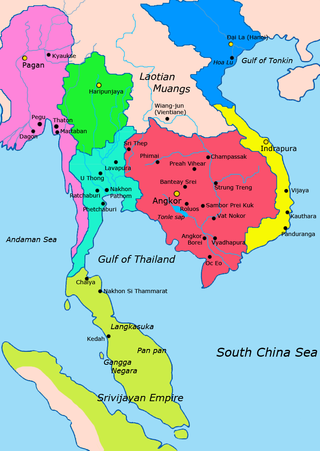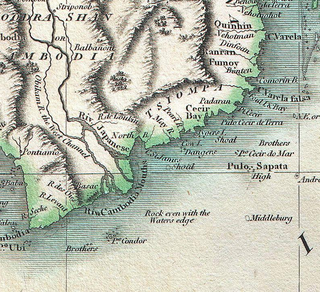
The history of Vietnam can be traced back to around 20,000 years ago. The first modern humans to arrive and settle in the area of modern-day Vietnam are known as the Hoabinhians, who can be traced as the ancestors of modern-day Negritos. Archaeological findings from 1965, which are still under research, show the remains of two hominins closely related to the Sinanthropus, dating as far back as the Middle Pleistocene era, roughly half a million years ago.

Champa was a collection of independent Cham polities that extended across the coast of what is contemporary present-day central and southern Vietnam from approximately the 2nd century AD until 1832, when the last remaining principality of Champa was annexed by the Vietnamese Nguyễn dynasty under its emperor Minh Mạng as part of its expansionist Nam tiến policy. The kingdom was known variously as Nagaracampa, Champa (ꨌꩌꨛꨩ) in modern Cham, and Châmpa (ចាម្ប៉ា) in the Khmer inscriptions, Chiêm Thành in Vietnamese and Zhànchéng in Chinese records.

Mỹ Sơn is a cluster of abandoned and partially ruined Hindu temples in central Vietnam, constructed between the 4th and the 14th century by the Kings of Champa, an Indianized kingdom of the Cham people. The temples are dedicated to the worship of the god Shiva, known under various local names, the most important of which is Bhadreshvara.
Nguyễn Phúc Chu was one of the Nguyễn lords who ruled southern Vietnam from 1691 to 1725. During his time in power, he had to deal with a Champa rebellion and the first major war against the Cambodians. Nguyễn Phúc Chu was the eldest son of Nguyễn Phúc Trăn. He gained the throne on his father's early death, at just 15 years old. He took for himself the title Tong Quan-Cong.
Po Binasuor, Ngo-ta Ngo-che, Cei Bunga, Chế Bồng Nga ruled Champa from 1360–1390 CE. He was also known as The Red King in Vietnamese stories. He is differed from Po Binnasuar, the king of Panduranga from 1316-1361.
Bhadravarman or Phạm Hồ Đạt, was the king of Champa from 380 to 413. In 380, Bhadravarman, the son or grandson of Fan Fo, took the throne with the regal name Dharmamahārāja Śrī Bhadravarman I, "Great King of the Law Bhadravarman".

Indrapura was the capital city of the kingdom of Champa from 875 AD until 982, or until 12th century AD. It was built and ruled under the reign of Buddhist king Indravarman II and some of his successors belonging to the Bhrgu dynasty in Đồng Dương. The word Indrapura means "City of Indra" in Sanskrit, Indra being the Hindu God of Storm and War, and King of the Gods in the Rig Veda.
The history of Champa begins in prehistory with the migration of the ancestors of the Cham people to mainland Southeast Asia and the founding of their Indianized maritime kingdom based in what is now central Vietnam in the early centuries AD, and ends when the final vestiges of the kingdom were annexed and absorbed by Vietnam in 1832.

Lâm Ấp was a kingdom located in central Vietnam that existed from around 192 AD to 629 AD in what is today central Vietnam, and was one of the earliest recorded Champa kingdoms. The name Linyi however had been employed by official Chinese histories from 192 to even 758 AD to describe a particular early Champa kingdom located north of the Hải Vân Pass. The ruins of its capital, the ancient city of Kandapurpura is now located in Long Tho Hill, 3 kilometers to the west of the city of Huế.
Trà Kiệu is a village in Duy Sơn commune, Duy Xuyên district, Quảng Nam province, Vietnam.
The Mathara dynasty ruled in the Kalinga region of eastern India during 4th and 5th centuries CE. Their territory included parts of the area between the present-day Ganjam district of Odisha in north and the Srikakulam district in Andhra Pradesh in the south. They appear to have been overthrown by the Pitrbhakta dynasty.
The Pitrbhakta dynasty ruled in the Kalinga region of eastern India in the fifth century CE. Their territory included parts of the present-day northern Andhra Pradesh and the southern Odisha. They probably overthrew the Mathara dynasty.

Panduranga or Prangdarang was a Cham Principality and later, the rump state successor of the Champa kingdom, which was destroyed by Vietnamese emperor Le Thanh Tong in 1471. It was located in present-day Southcentral Vietnam. It stood until late 17th century as the Nguyen lords of Cochinchina, a powerful Vietnamese clan, vassalized it and put the Cham polity under the name Principality of Thuận Thành.
Jaya Harivarman I was a Cham noble and King of Champa. Rising to power during the 12th Century Khmer–Cham wars, he spent much of his rule consolidating his control over Champa. He was succeeded by his son, Jaya Harivarman II.

Vikrāntavarman I or Prakāśadharma, was a king of Champa from the Gangaraja (Simhapura) dynasty, modern-day Central Vietnam, reigning from 653 to 686. His original name was Prakāśadharma but he took the appellation Vikrāntavarman when he was crowned in 653. He was the son of Prince Jagaddharma, the grandson of Kandarpadharma, and Princess Sarväpi, daughter of king Isanavarman I of Zhenla. He sent embassies to the court of Emperor Gaozong of Tang in 653, 654, 669, and 670, which he was known as Zhu Ghedi (諸葛地) and Bojiashebamo, as recorded in the New Book of Tang. He was known for expanding the Champa kingdom to the south, uniting the realm under one dynasty.
Gangaraja was a king of early Champa. He was the founder of Gangaraja dynasty.
Prithivindravarman (?–774) was a king of Champa, reigning from 758 to around 770.
Harivarman IV or Prince Thäng (?–1081), Sanskrit name Vishnumürti, was the ruling king of Champa from 1074 to 1080. His father was a noble belonging to the Coconut clan, and his mother was a member of the Areca clan.

Xitu was the Chinese designation for a historical region or a Chamic polity or kingdom that was first mentioned in the mid of fifth century AD, is believed to be one of the predecessors of Champa Kingdom. It has been proposed to be located in the Thu Bồn River Valley, present-day Quảng Nam Province, Central Vietnam.






